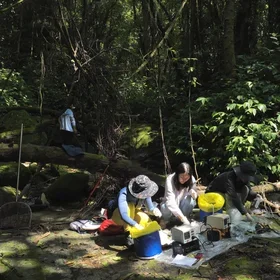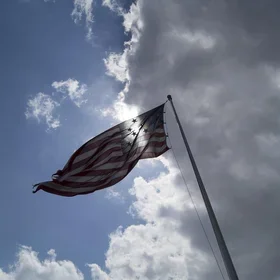Dr. Steve Cohen is the Sustainability Management program director and the School of Professional Studies senior vice dean. His new book, Environmentally Sustainable Growth: A Pragmatic Approach, will be published in May 2023. This book offers a positive vision of an environmentally sustainable future and lays out the steps ahead as we make the transition.
--
By Steve Cohen
I lived in Buffalo for four years in graduate school, including during the blizzard of 1977. People in western New York know how to deal with snow. In Buffalo, any snowfall under 6 inches is reported as snow “flurries.” (In Washington D.C., anything over 3 inches is a “blizzard.”) Nevertheless, the blizzard that hit western New York this past December resulted in over 40 deaths in Erie County, the county that Buffalo sits within. When the remnants of Hurricane Ida hit the New York Metro area in 2021, over 40 people died, including 13 in New York City—most of whom died in flooded basement apartments in Queens. There is little question that the United States is experiencing a rapidly growing number of extreme weather events and that these storms are worse than any of us remember. The new field of climate science called “attribution science” tells us that while storms are normal and natural occurrences, they are occurring more intensely and more frequently due to warming oceans and our warming planet. This is not news; everyone knows it because we are all experiencing it firsthand. In the famous words of Bob Dylan: “You don’t need a weatherman to know which way the wind blows.”
Still, our communities and even our highly capable first responders continue to be faced with unprecedented weather emergencies. In New York City, we prepared for floods along the shoreline, but the Ida emergency was the result of five inches of rain in an hour, and the biggest impact was nowhere near the shore. In Buffalo, the ferocity and duration of the December snowstorm had never been seen before. We need to learn from these experiences since it will take decades to mitigate climate change and much longer to reduce these types of impacts.
Last week, I had the honor of teaching for a morning at the Fire Department Officer Management Institute, a partnership between the FDNY and Columbia University’s School of International and Public Affairs. My subject was the impact of climate change on first response. We discussed the causes of climate change and the impact of decarbonization on the physical setting of the city. These days, New York City’s firefighters and EMS workers must maneuver around bike lanes and bike docking stations and increasingly are responding to fires from defective bike batteries. We then discussed the personal experiences these officers had faced due to climate change. One officer spoke about the impact of warming weather on winter sports like ice skating and skiing. Another noted that, in the summer, air conditioning was needed more often than a few decades ago.
Then we delved into the professional lessons learned from Hurricanes Sandy and Ida. New equipment and vehicles have gradually been made available to the FDNY to help them rescue people and fight fires during floods. Training in how to use that equipment has become routine. In addition, improved communication has been established to ensure coordination across the city during emergencies. Fortunately, unlike the Russian army and more like the Ukrainian army, FDNY officers are empowered to make decisions when they cannot communicate up the chain of command. The FDNY includes New York’s Emergency Management Service (EMS), 14,500 people who manage and respond to emergencies in New York City. When you call 911 with a health emergency, they often respond in an NYC ambulance. Along with firefighters, these public servants are always on duty to respond to life-threatening emergencies.
When I reflect on my morning with the fire and EMS managers, I am reassured that, at least in New York City, our first responders were working hard to improve their capacity to respond to emergencies in our warmer, wetter, and changing city. They requested and received new equipment and vehicles and are working hard to be ready for the next Sandy or Ida. But when I look at some rural places without large numbers of professional first responders and cities that do not have New York City’s tax base and the FDNY’s organizational capacity, I worry about America’s ability to deal with this growing threat to our personal security.
I know the politics of the moment is focused on ideological debates about policing, crime, and punishment, but it may well be we are paying attention to the wrong threat to our security. Most of us (fortunately) have not been victims of crime. Nearly all of us (unfortunately) have been victims of extreme weather events. Our homes have been flooded, our electric supply has failed, we’ve been stuck on flooded or frozen highways, or seen our communities knocked down by hurricanes and tornadoes. A nation as rich as ours has the resources to protect us from most harm; but do we have the wisdom to invest those resources in the staff, training, and equipment first responders need to save lives?
In addition to response capacity, I have written many times about the need for a more systematic and assured process of reconstruction. We’ve all seen the news coverage: A retired couple has their life savings and a lifetime of memories destroyed in a storm that may only last minutes. They have nowhere to go and face a future of hardship and uncertainty. The irreducible function of government is to protect its citizens from harm. Perhaps the home that was destroyed was too close to a forest or a shoreline. But the government’s rules on zoning and building permitted it. Sometimes, the home is in a place considered safe from harm, but the harm comes anyway. In our more crowded and climate-challenged planet, more people are in the pathway of destruction from extreme weather events. There is no way to hide from extreme weather events—they can happen anywhere. These emergencies are increasingly routine.
As I’ve argued before, we need a national system of reconstruction insurance that automatically provides financial resources when communities, families, and individuals suffer losses from extreme weather events. Each of us should pay into that fund, and it should be allocated according to pre-set rules related to the degree of damage and the cost of reconstruction. Unlike standard homeowners or flood insurance, everyone who works would pay into the fund, and payments to victims would be made within 30 days of the destructive event. Eligible events would include both natural and human-made disasters.
What we need to learn is that most of us in America are fortunate to live lives that are secure and safe from violence and crime. Most—though far from all—of us have sufficient food, clothing, and shelter. But the world we live in has gotten smaller and more interconnected due to technology and more dangerous due to the impact of those technologies on the planet and human behavior. Government is needed to protect us from the dangers that descend upon us through no fault of our own. But we need to invest some income to pay for this new form of protection.
Similarly, we need to add resources to the national programs now in place to fund and train first responders. There are parts of the country that are woefully unprepared for our climate-challenged planet. Their leaders think that climate change is a dirty word, refuse to raise taxes for anything, and think that government is a problem, not a resource to solve problems. Their constituents, often the victims of climate-accelerated extreme weather events, are less concerned about the cause of their disaster than the resolution of their suffering. These victims are not to blame for the short-sighted behavior of their leaders. We need to learn from the emergencies we are confronting because they are coming back, and each time they do, they will retain their capacity for surprise. New York City’s FDNY, including the department’s EMS, are at the top of their class in learning from the past and enhancing their ability to respond in the future. As a resident of New York City, I have confidence in their competence. We need to make sure that all Americans feel the way that I do about their first responders.
This article was originally published in State of the Planet.
Views and opinions expressed here are those of the authors and do not necessarily reflect the official position of the Columbia Climate School, Earth Institute, or Columbia University.
About the Program
The Columbia University M.S. in Sustainability Management provides students cutting-edge policy and management tools they can use to help public and private organizations and governments address environmental impacts and risks, pollution control, and remediation to achieve sustainability. The program is customized for working professionals and is offered as both a full- and part-time course of study.
The Sustainability Management application deadline for fall 2023 is May 15, 2023. Learn more here



